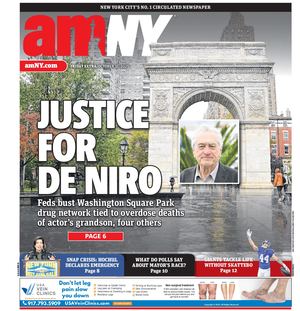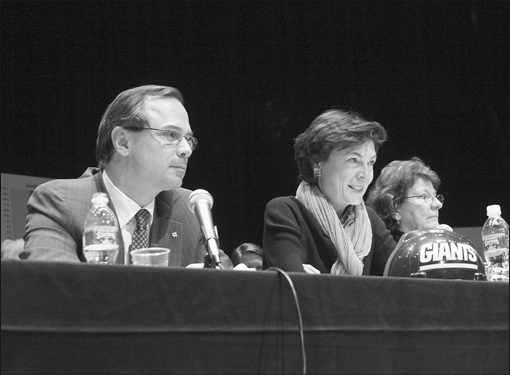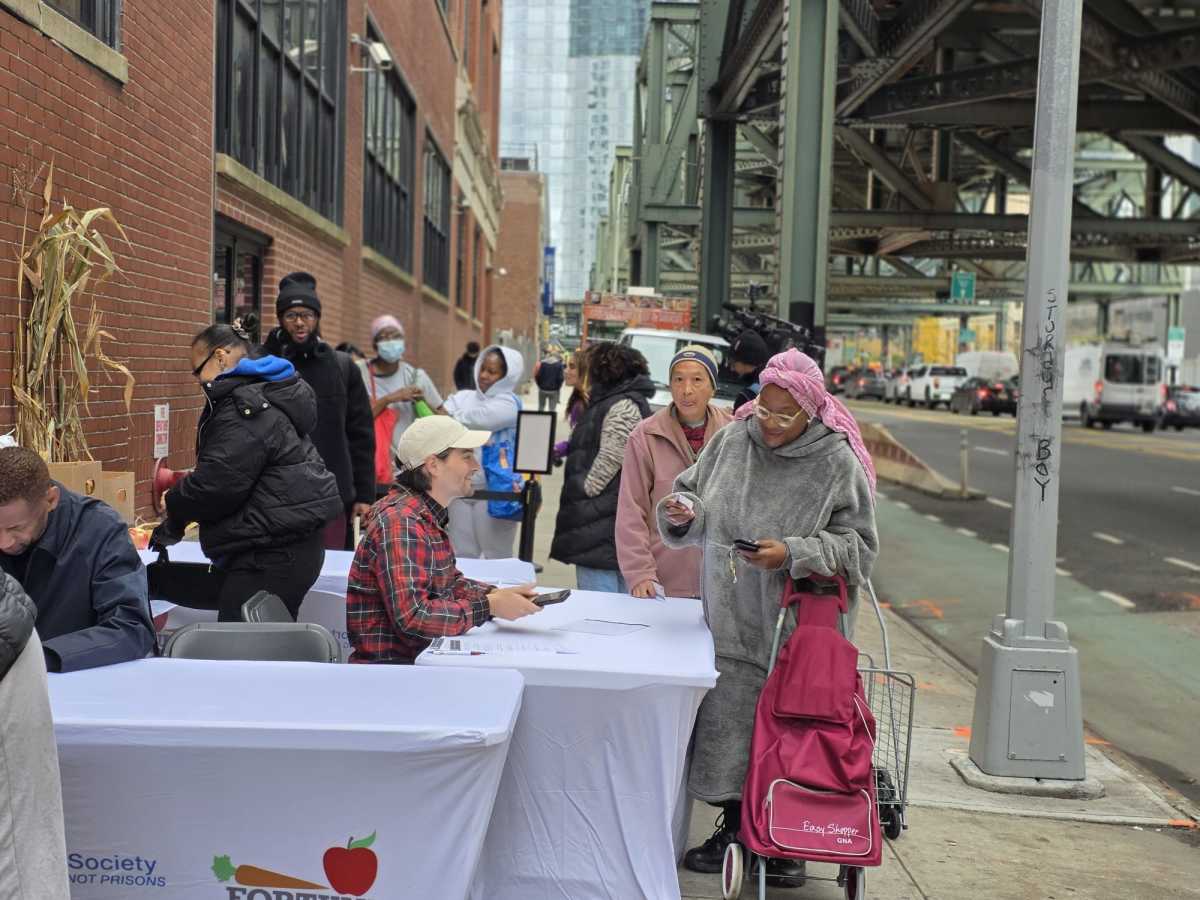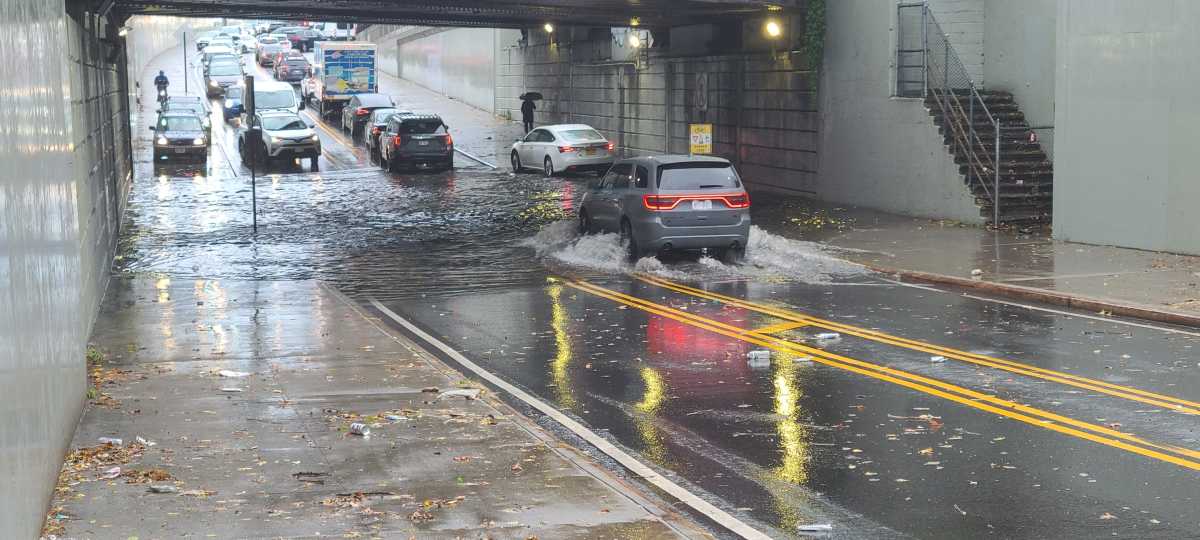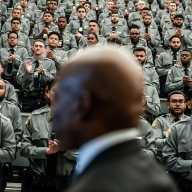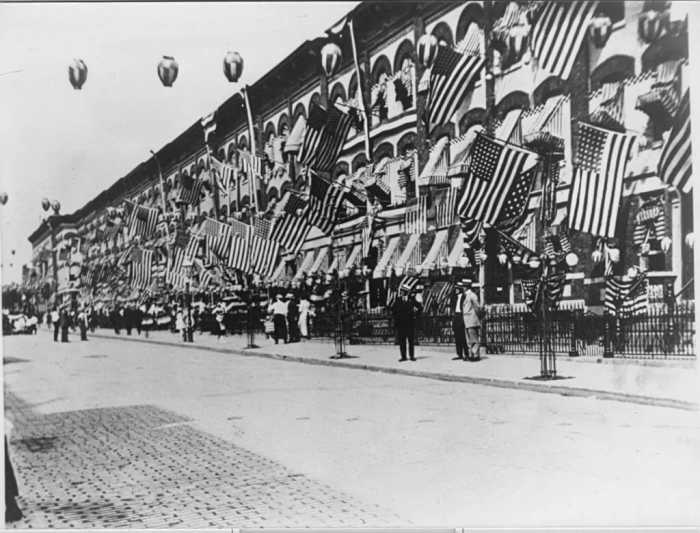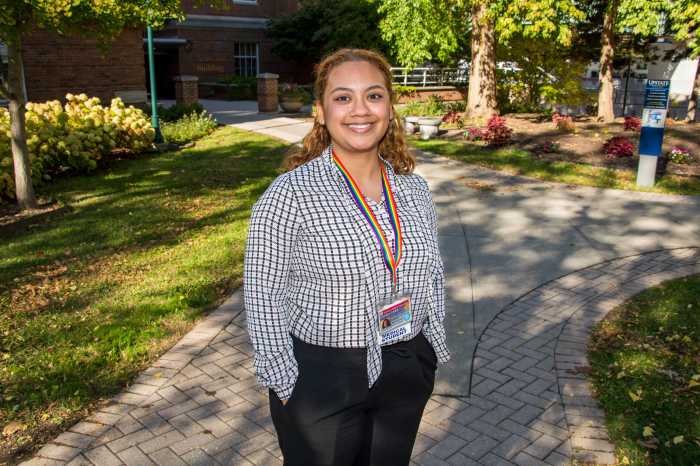By Lincoln Anderson with Josh Rogers
With tension over Pier 40 reaching an all-time high, about 200 people packed The Museum of Jewish Heritage last Thursday afternoon. They anxiously came to see if the Hudson River Park Trust’s directors would really vote to transform the pier into a glitzy Downtown entertainment center or, instead, heed the community’s repeated pleas to preserve the pier as a safe space for young kids to play soccer and baseball.
“There are a lot of people who are extremely passionate about this pier,” Diana Taylor, the Trust’s chairperson, acknowledged to the audience. “This pier — it’s incredibly important that we get it right. It’s important for this park, it’s important for this community, and it’s important for this city.
Taylor expressed faith in the Trust’s efforts to find the best way to repair the massive but crumbling W. Houston St. pier — and then program its use for at least the next three decades.
“I feel confident that it’s going to come out with something we all can live with,” she said.
Ultimately, the Trust did not vote, with Taylor saying Pier 40 would be on the agenda again for a possible vote in two months at the board’s next meeting at the end of March. But many of the Trust’s 13 board of directors members did air their thoughts at the meeting about the challenges facing Pier 40 — in the process illuminating where they stand on the contentious issue.
The day before the Trust’s board meeting, five local elected officials who were involved in crafting the 1998 Hudson River Park Act sent a joint letter to Taylor, stating what they feel are critical issues that should guide the Trust’s actions on Pier 40.
The officials — Congressmember Jerrold Nadler, State Senators Tom Duane and Martin Connor and Assemblymembers Deborah Glick and Richard Gottfried — explained that the park act should not be amended to give The Related Companies a long-term, 49-year lease for its plan for an 1,800-seat, Cirque du Soleil theater, a 12-screen cinema, a music hall and restaurants on the pier as part of a $618 million redevelopment scheme.
On Thursday, just hours before the Trust was to meet, City Council Speaker Christine Quinn wrote Taylor separately, echoing the state legislators’ opposition to a 49-year lease and support for a Pier 40 nonprofit conservancy.
At the meeting’s start, Marc Ameruso, president of the Hudson River Park Advisory Council, read the group’s resolution on Pier 40, voicing similar themes to those in the politicians’ letters; Related has not presented a plan for a 30-year lease, he stressed.
“The Related plan would be destructive to the fabric and character of the West Village, Lower West Side and Tribeca and would bear no relationship to rational urban planning,” Ameruso read from the resolution. “It would bear no relationship to the park to the north and south of Pier 40 and would require youth athletics to occur in an intensely developed entertainment complex.”
Former Parks Commissioner Henry Stern, an appointee of Mayor Bloomberg’s to the Trust’s board, scoffed at Ameruso’s remarks, stating, “It’s like a manifesto. You have to come to the real world.”
At a board meeting last year, Stern derided as “socialism” a suggestion in a report by the Pier 40 Working Group that the state and city should help finance the pier’s repair.
Connie Fishman, the Trust’s president, who heads the authority’s paid staff, in her report to the board members, stated that the second proposal submitted for the Pier 40 R.F.P. — The People’s Pier plan by Urban Dove and CampGroup — “has not documented the adequacy of their capital investment [and] understated their proposal’s development costs.”
The People’s Pier plan has been dogged by reports that the Trust does not consider it financially viable. Fishman also noted that Related still hasn’t demonstrated it can make its proposal work within a 30-year lease.
Mentioning the Pier 40 Partnership’s plan, Fishman said, “We applaud their initiative. And while we would like to continue their concept, there are a number of questions.”
Taylor, the state’s former superintendent of banks, told Downtown Express after the meeting that she had questions about the viability of bonds tied to parking revenue. She does think the Partnership’s financing mix is what will be needed on the pier.
“There’ll probably be tax-exempt financing, taxable debt and equity involved,” she said.
Taylor added that Related would probably not be able to be selected unless it partnered with a group that could sell tax-exempt bonds.
The Partnership formed to combat Related’s plan and the Trust’s efforts to bring the two together have not produced a compromise because Related has not been willing to eliminate any uses that draw large numbers of visitors to the pier.
Chris McGinnis, a Partnership member, said that he has discussed issuing bonds tied to parking revenue with Pat Foye, the chairperson of the Empire State Development Corp., who thinks it is a viable option.
Just a few days before the vote, the Trust asked Daniel Kurtz, an attorney in private practice who previously worked in former New York State Attorney General Robert Abrams’s office, to scrutinize the Partnership’s feasibility study for the pier.
However, in the Partnership’s defense, Kurtz in his report noted that they have only produced a feasibility study so far, not a full-fledged proposal.
Parks Commissioner Adrian Benepe, a mayoral appointee to the Trust’s board, asked Fishman if Pier 40 would have to be shut down if more money isn’t generated by it to pay for critical repairs to its 40-plus-years-old structure.
Parking at Pier 40 is one of the main generators of income for maintenance in the park, Fishman said. She stressed the urgent need to repair the pier.
“The first and most important issue is the roof of Pier 40,” she said. “We do have areas where concrete has fallen. Luckily, it has not fallen when anyone was there, just on cars.”
In the worst-case scenario, the Trust would have to start closing sections of Pier 40 as they become unsafe, she said.
“You wouldn’t take the whole pier and wrap it in yellow tape,” she explained. Rather, areas above where the metal support piles had weakened beneath would be selectively roped off, she said. On the rooftop, cars would be restricted from driving over dangerously deteriorated sections.
Fishman said the piles are in worse shape around the edges of the pier, the areas that support the two-story pier shed building, as opposed to beneath the central courtyard, where the artificial-turf sports field is. While that’s good news for the field and the kids and families that use it, if the pier’s parking has to be cut as a result of the pier’s condition, it will mean less money for the pier and park, she noted.
HR&A, the Pier 40 Partnership’s consultants, have determined the pier needs up to $125 million in repairs to its substructure — though a good chunk of this would be for a $43 million seismic upgrade that not all believe is legally required. For its part, Related Companies has said it would spend $30 million to repair the pier’s metal support pilings. But the HR&A report says the piles need $50 million worth of repairs. The pier’s roof needs a $21 million fix, HR&A concluded.
Deputy Mayor Robert Lieber, who replaces former Deputy Mayor Dan Doctoroff on the Trust’s board as its most powerful city appointee, said the city doesn’t have the cash to help fix Pier 40.
“There’s an excess of needs and a shortage of funds throughout the city,” he said. “So there’s no surplus of funds to use for this type of activity.”
Then, Benepe, in the most-deflating comments of the meeting in the view of local park activists and community members, started talking about uses in other city parks that draw great numbers of people. Related’s Pier 40 plan would attract 2.5 million people annually to Pier 40. (Initially, Related had cited an even higher number of 2.7 million per year, before making some slight modifications to its plan.)
“I know it sounds like a lot, 2.7 million,” Benepe said, “but it’s roughly half the number of annual visitors that go to the Met [which is located in Central Park].” The Central Park Zoo is another major in-park attraction, he said.
“I think closing your mind to the idea of things that are not traditionally park-like — like a circus — is a bit hasty,” Benepe said.
However, speaking after Benepe, Julie Nadel, one of three “community” members appointed to the board by Borough President Scott Stringer, drew a sustained ovation from the audience when she said Pier 40’s park character should not be compromised by commercialism.
“Pier 40 should be integrated into the neighborhood it abuts,” she said. “People talk about world-class parks — it’s also a community park. Whatever goes into the park should mainly benefit the community; that was one of the main fears about Related.”
“If you want to have revenue, you’ve got to have people,” Stern said. “Each person leaves a few dollars. If you want to have a park, you have to pay for it. You have to have some activity there that will cause them to part with their money — whether it’s movies or a stag show.”
Paul Ullman, a new Trust board director — whose wife was until recently a member of the Pier 40 Partnership — then spoke. Getting right to the point, he described a plan for the pier that is basically the Partnership proposal, though he did not mention the Partnership by name.
“There is a viable plan, in the $200 million to $300 million range,” he said. “It would have tax-free financing that would be secured by parking, at a minimum, and very possibly other nonprofit uses.” There would be $30 million to $40 million in private financing, he continued, and an educational space for a public school or college. There would be some for-profit athletic uses, too. Ullman later clarified that this for-profit sports space would only be some tennis bubbles on the pier’s rooftop, and that he wasn’t referring to the pier’s sports fields.
Ullman told the board to “keep the pressure going and build upon that” and urged them to set a deadline for a decision on the pier.
Although the community wants the Trust to close the R.F.P. and move ahead with the Partnership’s idea, Taylor kept the R.F.P. process alive for at least two more months.
“We’re not going to get any money from any other government agency,” she said. “We’ve been at this for a very long time. … We’re very limited in the alternatives we actually have,” she said, referring to the two flawed R.F.P. responses and the Partnership’s new idea. “Doing nothing is not an option,” Taylor said. She said the board should continue to “work through” the issues during the next two months.
Afterward, reactions among elected officials and community members ranged from frustration to guarded optimism.
Arthur Schwartz, chairperson of the Pier 40 Working Group and chairperson of Community Board 2’s Waterfront Committee, said he was dismayed to see Bloomberg’s appointees defending the idea of turning Pier 40 into a major entertainment hub.
“I was pretty disappointed at what Benepe had to say,” Schwartz noted. “It looks like the mayor’s appointees are really walking in lockstep.”
Speaking on Monday, he sounded even more upset: “People are really pissed the way the community was described at the board meeting,” he said. He added that the Pier 40 Working Group had drafted resolutions to write one letter requesting that, not just the Trust’s staff, but its directors too, meet with the chairpersons of Community Boards 1, 2 and 3 and the Working Group, and another letter to the governor and borough president, requesting that they get actively involved in the Pier 40 debate.
Tobi Bergman, president of Pier, Park & Playground Association and chairperson of C.B. 2’s Parks Committee, said: “I was surprised that Adrian Benepe was not more concerned about the idea of placing a massive entertainment district in the midst of a park. He pointed to examples around the city where there are uses that bring millions of visitors to city parks. But the examples he gave were uses our community would love to see at Pier 40, including entirely appropriate public uses, such as museums and zoos with minimal nighttime visits and none of the park and neighborhood impacts of the Related proposal.”
McGinnis, the Partnership member, said they wished the Trust had closed the R.F.P. because that would open up the process and make it easier to negotiate about financial details and move forward. Because of the confidentiality agreement the developers must sign for the R.F.P., much about the Related and People’s Pier proposals — such as critical financial information — is shrouded in secrecy.
Said Trust board member Nadel, “I think that maybe the idea is to get the Partnership and Related to come together — but I don’t see how that’s going to happen. This is a unique situation.”
Rich Caccappolo, another Partnership member, said the Partnership was at least glad that the Trust didn’t agree to back a 49-year lease for Related.
“We’re slightly disappointed, but not surprised, that they didn’t close out the R.F.P.,” he said. Caccappolo said it’s clear that the Trust feels “Related is the easiest way to go forward,” and also that the state-city park authority would like the Partnership to synergize somehow with Related. Only because the Trust asked them to, the Partnership previously held meetings with Related, but there was no progress.
“Very difficult,” Caccappolo said of those meetings. “They were discussions geared toward getting Related to reduce some of the intense, high-impact uses. At the end of the day, they said they couldn’t really change any part of the plan — that is, the circus, the movie theaters, the banquet hall, the music hall; we went one by one.”
Asked if Related wants to work with the Partnership, Joanna Rose, a Related spokesperson, said, “We continue to believe that this is an important project for the city, the park and the community and we’ve agreed to continue discussions with the Trust and other interested parties.”
